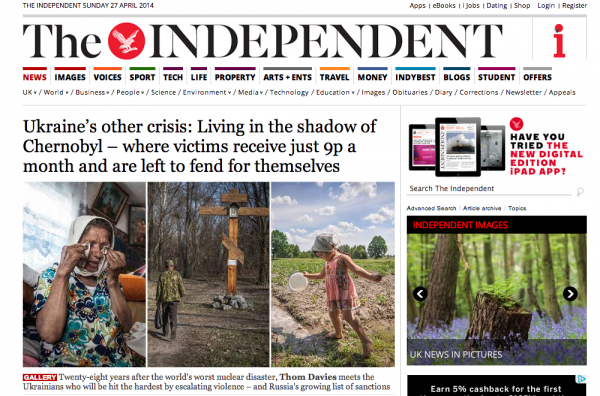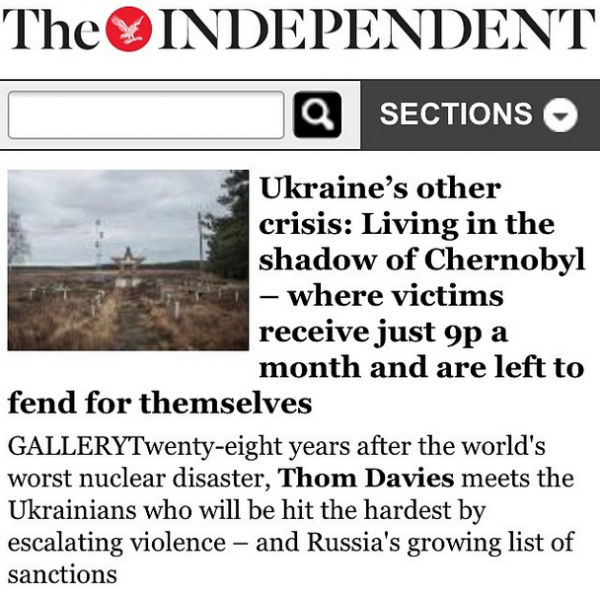Human geography beyond the ‘Ivory Tower’:
With all-eyes on Ukraine at the moment, I have published an article in The Independent that highlights the struggle of those who live with the consequences of the nuclear disaster in Ukraine. This is based on my academic research in Chernobyl-affected regions of Ukraine.The article has been the lead piece on The Independent website all Sunday and is getting a lot of traffic on twitter/facebook etc. I am glad that my research is reaching a wider audience and that this important topic is being spoken about.You can access a copy of the piece on my academia.edu page, or the original article here.Photographic images are key to telling this story. My own photographs and those of my very talented friend Alexey Furman can be seen in the original article.
I did not chose the title of the article – that privilege lies with the editor – but the rest are my words and the words of those I met:
Ukraine’s other crisis: Living in the shadow of Chernobyl – where victims receive just 9p a month and are left to fend for themselves
The yellow and blue flag of Ukraine is an imaginary landscape. It supposedly symbolizes the endless fields and blue skies of a Ukrainian rural idyll.
Gazing north near the border with Chernobyl, one can be forgiven for being taken in by this fantasy; the yellow unploughed fields stretching out to the horizon. The illusion is broken however, by a distant strip of green conifer trees and disused pylons where the sky meets the earth. Beyond these trees lies the Exclusion Zone.
“We are like bugs on a potato” explains Viktor, standing on his field that backs on to the barbed wire fence of Chernobyl’s nuclear Exclusion Zone: “These bugs are not afraid of anything and nor are we, if you try to kill them – they are still alive, and we are the same”. Like many others who live on territory officially deemed contaminated by Chernobyl, he receives just 9p per month in compensation to ‘buy clean food’. “What can I do with this?” he asks, “It won’t even buy a loaf of bread”.
As the turmoil in Ukraine intensifies and the physical violence enacted upon Ukrainian citizens by bullet, truncheon or Molotov cocktail continues, another more stealthy form of violence continues to impact the lives of thousands of people – that of state-abandonment. This weekend marks the 28th anniversary of the world’s worst nuclear tragedy. With Ukraine’s economy on its knees and Russia at its throat, it is Chernobyl’s marginalized citizens who rely on dwindling compensation that are placed at the thin edge of this geopolitical crisis.
Earlier this month Russia announced an 80% increase in gas prices for Ukraine. Likewise, the IMF loan offered by the West in the wake of Crimea’s annexation has come with many strings attached, namely a long list of austerity measures that make the 2010 deal with Greece seem like a philanthropic gesture. Kiev’s floundering interim government are curtailing social services and slashing benefits whilst a depression on a scale not seen since the collapse of communism seems inevitable.
Ukrainians, one in four of whom are already below the poverty line, lie sandwiched between two geopolitical antipodes and are set to feel the full force of these austerity measures and gas hikes. Perhaps no group more so than the exposed victims of Chernobyl.
“This is war without war” explains Masha, who lives a few minutes walk from the forbidden spaces of the Zone – a cordoned off area of north-central Ukraine roughly the size of Oxfordshire. Like Viktor, she too receives virtually nothing in terms of compensation. Her tiny state pension – barely enough to make ends meet – is set to decrease further in the first round of President Yatsinyuk’s austerity measures. “We have a lot of diseases too” she adds “I can’t sleep now”.
But she, like many others, has other ways of coping. She grows her own food in the contaminated soil, “cucumbers, potatoes, you name it” and even illegally sneaks through holes cut in the fence around Chernobyl, deep into the radiated forests to gather mushrooms and berries. Some she pickles in jars for the uncertain year ahead, and others are sold on the streets of Kiev. The police sometimes catch her in the Zone but they are often more interested in eliciting bribes than arresting her.
Others collect scrap metal from the Zone in their bid to survive an absent state and failing economy. “If you can, then you steal something, if you cannot steal something – you are hungry” explains one man who regularly ventures into the forbidden forest. Selling the abandoned detritus and infrastructure of the Zone, left by the thousands of forced evacuees 28 years ago, has become an informal lifeline to many people who live in the shadows of Chernobyl.
People affected by the tragedy have been exposed twice – once to the invisible threat of radiation, and once more to a state that does not care. Liquidators for example, who risked their health in the wake of nuclear meltdown to clean up the contaminated landscape, today regularly struggle to claim the compensation they deserve.
“Do I have to die to prove I am a liquidator?” asks one woman from Kharkhiv, desperate for compensation to help buy medicines for illnesses she relates to Chernobyl. Their damaged biologies and psychological scars are testament to a state that has failed them.
Estimates of fatalities from the disaster vary wildly, from the IAEA’s figure of 4000 up to nearly one million. But any number hides the real human cost of the tragedy: the lives ruined, the dismembered communities, and the invisible poison of stress.
“You should see the cemeteries there” Viktor tells me, referring to the places where the 350,000 Chernobyl evacuees were sent, “they are like cities”.
There is a widely held belief that those who were forcibly evacuated have died from stress. As one evacuee tells me, who now lives 500 miles away from her childhood home in the Exclusion Zone: “We are like a tree that has been uprooted, and taken from our own land. There’s only a small chance that this tree will survive and grow in the new soil.”
Recent months have seen Lenin statues forcibly removed from Ukraine’s urban landscape, but the nuclear legacy of the Soviet Union is harder to erase. It is an inheritance that consumes around 5% of Ukraine’s budget each year, a cost that the post-IMF government will be targeting in its path towards austerity.
The dust will eventually settle on the ongoing unrest in Ukraine. Borders may even change. But long after the world turns away from Ukraine, people like Viktor and Masha will still be there, struggling on the edge of a forgotten tragedy – like bugs on a potato, attached to the soil.”
– Photographs by Alexey Furman and Thom Davies
# Chernobyl, Chernobyl photography, The Independent, Ukraine crisis, Ukraine's other crisis
0







Leave a Reply